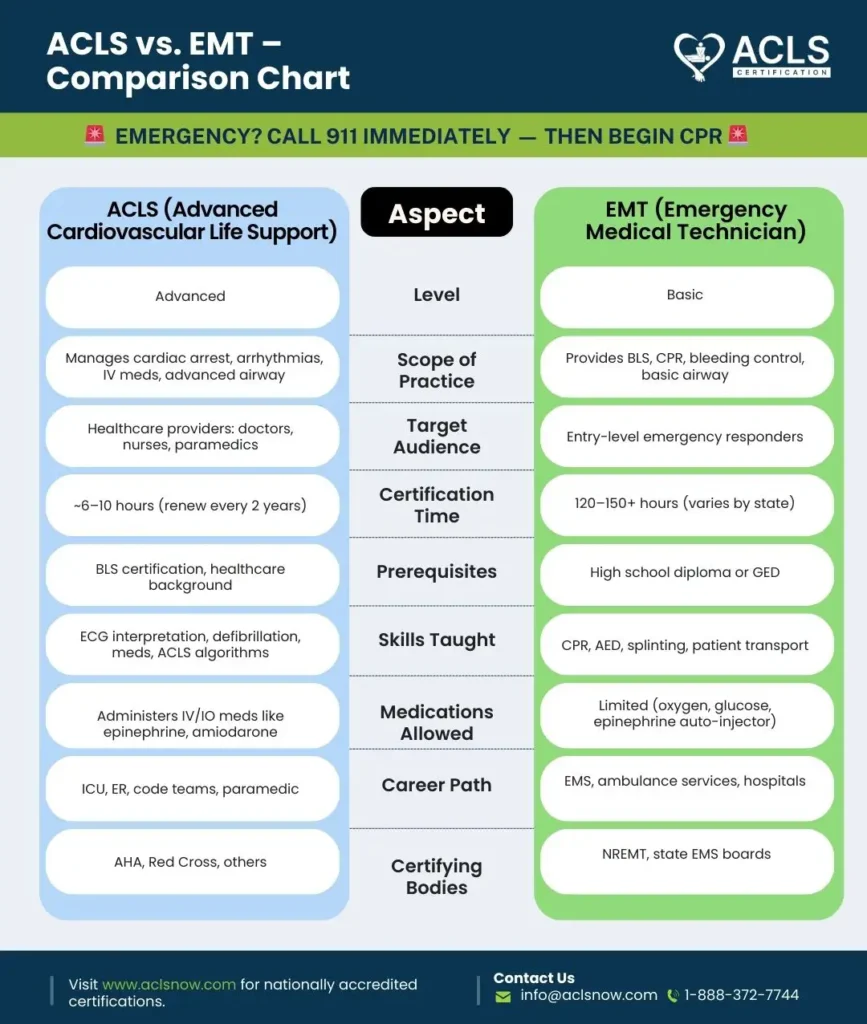Advanced cardiac life support and emergency medical technicians play crucial roles in emergency medical care. It is important to understand the differences between the two. ACLS and EMTs’ both play crucial roles in saving lives; however, their training and scope vary. They differ in training and scope of practice. Healthcare professionals, such as nurses and doctors, pursue ACLS certification. They manage severe cardiac emergencies, including strokes and heart attacks.
On the other hand, EMTs’ are the first responders in emergencies and provide vital pre-hospital care. Their training involves basic life support skills, including wound care and CPR. However, it is crucial to note that they do not perform invasive measures. In this blog, we will further understand these roles and the right approach to emergency medical services.
Master ACLS Now
Get ACLS certified with confidence
What is ACLS?
ACLS stands for advanced cardiac life support. It comprises a set of clinical interventions that help treat patients experiencing cardiac emergencies. ACLS providers can easily recognize and respond to life-threatening emergencies. They also provide medications, perform advanced airway management, and coordinate effectively while resuscitating.
What is an emergency medical technician?
An emergency medical technician is a healthcare professional providing emergency care. They are the first responders to accidents and cardiovascular attacks. They diagnose the patient and offer immediate support. Additionally, they take patients to the hospital for further diagnosis and treatment.
What are the differences between ACLS and an emergency medical technician?
While both ACLS and EMTs are crucial in emergency medical care, there are significant differences, such as the following:
| Aspect | Advanced cardiac life support | Emergency medical technician |
| Primary role | Manage cardiac life support (ACLS) | Provide immediate pre-hospital care and transport |
| Certification type | Healthcare professionals such as nurses and doctors | Pre-hospital care providers. These include firefighters and paramedics. |
| Training focus | Trains for advanced techniques for stroke, cardiac arrest and other cardiovascular emergencies. | Basic life support, trauma, respiratory emergencies and diagnosis of patients. |
| Key skills | Intubation, ECG interpretation and defibrillation. | Automated external defibrillator, CPR, wound care, and oxygen administration. |
| Scope of practice | Advanced interventions and invasive procedures | Does not perform any invasive procedures |
| Work environment | Specialized medical settings, hospitals and advanced life support units | Emergency situations, ambulances. |
| Emergency care level | Offers advanced life support. | Offers basic to intermediate life support. |
| Typical situations | Cardiac arrest, acute stroke, severe arrhythmias. | Trauma and minor cardiac events. |
| Continuing education | Regular certification is required to stay current | Regular certification and continuing education helps maintain certification. |
Read more: How Many Ceus For ACLS?
ACLS vs. emergency medical technician
Now that we have an understanding of the differences, let us understand more about the differences in their job descriptions.
ACLS provider:
Here are the primary job responsibilities of an ACLS provider:
- Recognize cardiac emergencies, such as cardiac arrest.
- Perform advanced airway management techniques, such as ventilation.
- Interpret electrocardiograms and identify cardiac abnormalities.
- Coordinate effectively during resuscitation.
- Offer care post-cardiac arrest.
Emergency medical technician:
Here are the key responsibilities of an emergency medical technician:
- Respond to emergency calls and offer basic life support to patients.
- Assess the condition of patients and offer medical help.
- Stabilize the patients and ensure that they are safe while being taken to the hospital.
- Perform resuscitation and control bleeding.
- Assist other medical professionals in providing prompt care.
- Document all information relevant to patients.
What are the education and training requirements of ACLS providers vs. EMT providers?
Here are the education and training requirements for ACLS providers and EMTs’:
ACLS provider:
- Must have a healthcare background, such as as a nurse or a doctor.
- Must have completed a certified ACLS course.
- Must pass a written exam and know all ACLS interventions.
- Must maintain ACLS certification by taking timely renewal courses.
Emergency medical technician:
- Must complete a certified EMT training program.
- Must pass the National Registry of Emergency Medical Technicians certification exam.
- Must obtain state certification, which may require additional exams or requirements.
- Must complete continuing education courses and maintain certification.
ACLS vs. emergency medical technician: Career outlook and salary
The career outlook can vary based on the factors mentioned below:
ACLS provider: The career outlook and salary for ACLS providers and EMTs can vary based on factors such as experience, location, and job setting.
ACLS provider:
- Job outlook: There shall be an increase in the demand for ACLS providers due to the increased issues related to cartilage as the population ages. As mentioned before, ACLS providers are employed in healthcare facilities such as hospitals and outpatient clinics.
- Salary: The average wage for ACLS providers is relative to one’s health care occupation. For instance, registered nurses who take ACLS certification exams get an average of $75,000 annually, while ACLS paramedics get an average of $40,000 annually.
Emergency Medical Technician:
- Job outlook: The employment of EMTs will also rise due to the rising population’s need for emergency medical services. Ambulance services, hospitals, and fire departments are some of the places where employment opportunities for EMTs exist.
- Salary: The estimated salary for the EMTs differs depending on the nature of work and certification level. EMTs’ annual wages are approximately $35,000; however, this figure may increase with further certification and job experience.
Read more: What To Do When Your ACLS Has Expired?
Conclusion
Choosing between ACLS and EMTs depends on your personal career choices and educational background. ACLS providers have an advanced scope of practice and require a healthcare background. On the other hand, EMTs’ offer crucial emergency care, providing rewarding career opportunities to individuals passionate about helping others.








